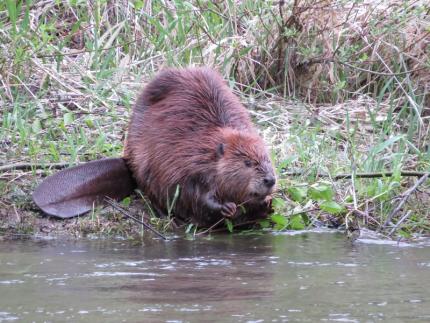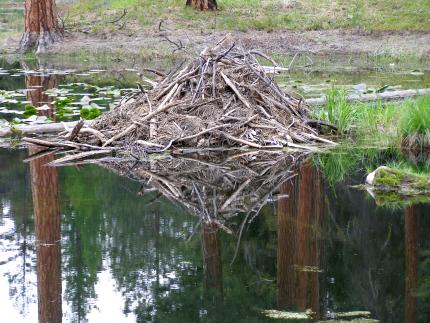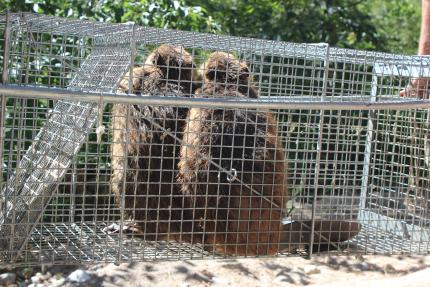The Washington Legislature recognizes that beavers play a significant role in maintaining the health of watersheds in the Pacific Northwest and that beaver relocation can be a beneficial wildlife management practice (RCW 77.32.585). The Washington Department of Fish and Wildlife (WDFW) issues permits to authorize beaver relocation under certain conditions. WDFW currently issues beaver relocation permits under a project per WAC 220-450-230. This program transitioned from pilot project to permanent project when this WAC was enacted in December 2024.

Our objective is to mitigate damage beavers cause and to reduce beaver mortalities. Beaver relocation serves as a last-resort alternative to lethal removal.
This program will evaluate draft requirements and conditions for obtaining a permit to capture, hold, transport, and release beavers in Washington. These include a process for:
- Identifying source beavers for capture and relocation
- Assessing sites for beaver release
- Beaver handling and transport
- Reporting and monitoring relocations
We are continually evaluating the beaver relocation program with the help of voluntary participants (permittees), who will ultimately inform how effective the relocation methods are.
Beaver Relocation Pilot FAQ
I have beavers on my property and there’s a conflict (flooding, tree losses, plugged culvert, etc.). What can I do?
We strongly recommend that landowners take measures to tolerate or mitigate beaver activity whenever possible. Please contact the following beaver mitigation experts to help determine your next best steps.
- Beavers Northwest - North Puget Sound
- Beaver Craftworks - South Puget Sound
- Methow Beaver Project - Okanogan Valley
- South Sound Beaver Recovery - South Puget Sound
- Wenatchee Entiat Beaver Project - Chelan County
I want a beaver relocated to my property. How can I get one?
Before you have a permittee relocate a beaver to your private property, you must evaluate the available habitat. Use the steps below to determine if your property is a good match for beavers without incurring any damage associated with their activities and see Receiving a beaver via relocation for more information.

- Evaluate your property for habitat suitability (PDF).
You must ensure that there are enough resources (ample food, water, cover, and space) for beavers to establish on the property. Good beaver habitat is unoccupied by other beavers, supplies building materials, provides protection from predators and suitable stream flow and geomorphology, and has a low risk of future negative interactions with people. - If habitat is suitable for a beaver release, next notify your neighbors of your intentions, and ask whether your neighbors would accept the beavers if they move to nearby properties.
- If the habitat is suitable and your neighbors accept, then contact a permitted beaver relocator to further assess your property’s potential for the beaver to survive and avoid potential damage (see permittee contact information below).
- With the permittee’s approval, fill out a Landowner Attestation Form (PDF).
It is critical that you communicate with your neighbors before you bring beavers onto the property. Beavers may not stay and establish where a permittee releases them, but may forage or establish on nearby habitat instead. Therefore, it’s essential that you have mutual recognition and agreement between neighboring landowners. - Follow the permittee’s directions.
What is a beaver relocation permit?
WDFW will issue a beaver relocation permit to selected voluntary participants. A beaver relocation permit authorizes the capture, transport, housing, and relocation of American beaver (Castor canadensis) within Washington, pursuant to RCW 77.32.585 and the conditions of the permit. The permit will only authorize beaver relocation in situations where:
- beaver damage mitigation efforts have failed or are infeasible
- where beavers are posing a public health and safety risk,
- or other irresolvable factors exist.
You can find a workflow of beaver relocation permittee responsibilities here.
You cannot relocate beavers without a permit or other authorization. Neither a trapping license nor a Wildlife Control Operator certification authorize beaver relocation. Private property owners cannot relocate beavers from their property without a permit. It is unlawful to take live wildlife from the wild without a permit, to hold live wildlife in captivity unless lawfully acquired, and to release wildlife from captivity (WAC 220-450-030), except as provided in WAC 220-450-010.
How do I become a permitted beaver relocator?

WDFW is planning to select a limited number of voluntary pilot participants each year. We may select participants throughout the duration of the pilot. To participate, you must meet all of the following criteria:
- Must be 18 years of age,
- Must not have within the last three years:
- More than one finding of "paid" or "committed", as final disposition, for an infraction under RCW 77.15, OR
- A conviction for a fish and wildlife crime under RCW 77.15,
- Must operate or have access to a Beaver Husbandry Facility that meets minimum requirements.
- Must submit a beaver relocation plan that describes the intent of relocations, area of work, and methods for identifying source beaver, capture, handling, transport, release site selection, release, and monitoring.
- Must submit a statement of qualifications and relevant experience.
- Must demonstrate willingness and ability to comply with all requirements of the pilot.
Note: WDFW will conduct a criminal history background check to verify the second requirement above.
You must also complete a comprehensive training on beaver relocation in Washington.
How do I get a permit to relocate beavers?
To request an application, contact BeaverRelocationPermit@dfw.wa.gov.
Do I need to be a Wildlife Control Operator (WCO) or licensed trapper to apply for a permit?
No, you do not need these qualifications to become a permitted beaver relocator. If you have a WCO certification or a trapping license, however, you will need to provide this information in your beaver relocation permit application.
People with a WCO certification or a trapping license may be listed as subpermittees on a beaver relocation permit. As subpermittees, they cannot release beavers unless under the supervision of a permittee. They may capture beavers following the regulations of their certificate or license. They may transport beavers for a permittee.
How long do permits last?
Permits are valid from their issue date through March 31 of the following year. For permit renewal, contact BeaverRelocationPermit@dfw.wa.gov.
What should I know about removing or modifying beaver dams?
To remove or modify a beaver dam you must have a Hydraulic Project Approval (HPA) – a permit WDFW issues for work that will use, obstruct, change, or divert the bed or flow of state waters (RCW 77.55).
Find a permitted beaver relocator
Methow Beaver Project
Alexa Whipple, 509-289-2770
Okanogan County
alexa.mbp@methowsalmon.org
Anabranch Solutions
Asotin, Garfield, Columbia, Whitman, Walla Walla counties
Sam.bango@anabranchsolutions.com
Eliza.keksi@anabranchsolutions.com
Cascade Forest Conservancy
Clark, Skamania, Lewis, Clickitat counties
amanda@cascadeforest.org
Wenatchee-Entiat Beaver Project
Chelan & Douglas counties
lisa.foster@tu.org
South Sound Beavers
Thurston, Mason, Pierce, King, Kitsap, Lewis, Cowlitz counties
markheckert@outlook.com
Tulalip Beaver Project – WDFW Tribal Relocation Partners
Molly Alves & Dylan Collins
Snohomish County
dcollins@tulaliptribes-nsn.gov